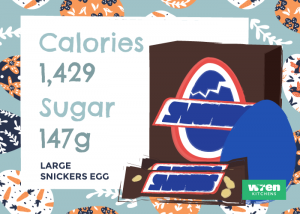UK’s unhealthiest Easter egg revealed: Which ones should you NOT give your kids?
From adorable chocolate bunnies to colourful egg-shaped delights, we’re well into Easter treat season, and the selection is more varied (and tempting!) than ever before.
But before you tear the packaging off the goodies the Easter Bunny delivers, it might be worth pausing and looking at the label. We’ve analysed the contents of some of the UK’s most popular eggs to find out just how many calories and how much sugar we (and our children) are indulging in.
Is one Easter snack better than another? And which chocolate treats are harbouring the most calorific secrets? We did the maths to find out…
Size matters
The selection of eggs available this year ranges from XS to XXL, and the nutritional contents of each varies across the different brands. But let’s take a step back from the world of eggs for a moment and look at some of the other Easter treats that hopped onto the supermarket shelves this year.
It seems that the Malteser Bunny, one of the smallest treats on offer at only 29g, is one of the healthier choices:
Malteser Bunny
- Calories: 156kcal
- Sugar: 15g
- Fat: 9g
While a 40g Creme Egg’s fat content is lower, it’s much higher in sugar than the Malteser Bunny:
Cadbury Creme Egg
- Calories: 177 kcal
- Sugar: 26.5g
- Fat: 6.1g
Though they might sound small, if you eat the whole 90g bag of Cadbury Mini Eggs in one sitting, they are actually one of the higher calorie choices!
Cadbury Mini Eggs
- Calories: 444kcal
- Sugar: 61.5g
- Fat: 19.2g
The main event
Last year, we surveyed the nation to find out just how much chocolate the average British child could expect to receive from friends and relatives. We learned that children are given a wide selection of eggs in small, medium, and large sizes, with the average receiving a total of 13 Easter eggs, plus additional treats.
With large Easter eggs offering arguably better value for money (after all, who doesn’t want more chocolate!), smaller Easter eggs are easier to dismiss as simple snacks, rather than a special treat.

Unfortunately, the larger the egg, the higher the sugar, fat, and calorie content. One of the most shocking results comes from the Large Cadbury Chopped Nut Egg, which contains the Easter egg itself and a single bar of chocolate:
Cadbury Chopped Nut Egg
- Calories: 2,977kcal
- Sugar: 285g
- Fat: 180g
A standard large egg, such as the Snickers Milk Chocolate Easter Egg – which comes with two 48g Snickers bars – is also incredibly indulgent:
Snickers Milk Chocolate Easter Egg
- Calories: 1,429
- Sugar: 147g
- Fat: 78g

Even the smaller eggs we receive can create a big dent in our recommended daily calorie allowance. A Medium Rolo Easter Egg, which contains a milk chocolate egg and Rolo milk chocolates, amounts to:
Medium Rolo Easter egg
- Calories: 720kcal
- Sugar: 84g
- Fat: 38g
And a Medium Cadbury Mini Egg Easter Egg also contains over a quarter of an adult’s recommended daily calorie intake:
Medium Cadbury Mini Egg Easter Egg
- Calories: 696kcal
- Sugar: 78g
- Fat: 63g
Cult status
Every year, certain eggs become must-have items thanks to the likes of social media trends and Good Housekeeping magazine, which ranks hundreds of eggs across various categories. How do these eggs compare to the mainstream choices?
Good Housekeeping had a surprising winner for 2018’s best egg. It’s vegan, which means it doesn’t contain any animal products. The Booja Booja Large Hazelnut Truffle Easter Egg features a painted egg filled with vegan hazelnut truffles. But just because it’s milk-free doesn’t mean it’s calorie free:
Booja Booja Large Hazelnut Truffle Easter Egg
- Calories: 838kcal
- Sugar: 37.2g
- Fat: 73g
Unbelievably, the winner of the ‘Best for Kids’ category by Good Housekeeping was the Lindt Giant Gold Bunny. If you choose to buy this whopping Easter egg for your child, they will eventually consume an entire kilogram of chocolate:
Lindt Giant Gold Bunny
- Calories: 5,500kcal
- Sugar: 550g
- Fat: 330g
One egg that’s certain to feature on your newsfeed this year is the Waitrose Avocado Easter Egg. Unusually designed, the egg features dark and white chocolate designed to look like an avocado, but the nutritional value reflects pure indulgence:
Waitrose Avocado Easter Egg
- Calories: 1,620kcal
- Sugar: 89g
- Fat: 114g
Our advice
There’s no shame in enjoying chocolate with your family this Easter, but there is a difference between indulging in treats and taking an unhealthy approach to Easter excessiveness. This is something we need to be mindful of when eating and giving Easter treats, particularly when it comes children.
Depending on the age of your child, they should only consume between 19g-30g of sugar per day, according to guidelines from the NHS. Some of the most popular Easter eggs contain double or even triple that amount.

Consider asking the Easter bunny to deliver a small egg (such as the Cadbury Dairy Milk Buttons egg – 462 calories, 26 grams of fat, and 48 grams of sugar) and restricting the amount they eat each day. That way, the chocolate can be enjoyed for longer, and they don’t consume more sugar than they should in one day.

And why not enjoy a family day out together over the long weekend? Visit somewhere new and walk around to explore the sights, or even just play games in the park. That way, you’ll all be more active, which makes up for the extra indulgences – and gives the whole family a great opportunity to spend time together, too.
Sources:
Disclaimer: All data is calculated based on nutritional information displayed by Tesco, Waitrose, Natural Collection, and Ocado as of 21/03/18.
- Malteser Bunny: https://www.tesco.com/groceries/en-GB/products/264282026
- Cadbury Creme Egg: https://www.tesco.com/groceries/en-GB/products/250237084
- Cadbury Mini Eggs: https://www.tesco.com/groceries/en-GB/products/251501501
- Cadbury Chopped Nut Egg: https://www.tesco.com/groceries/en-GB/products/299235260
- Snickers Milk Chocolate Egg: https://www.tesco.com/groceries/en-GB/products/295409976
- Medium Rolo Easter Egg: https://www.tesco.com/groceries/en-GB/products/255167901
- Cadbury Mini Egg Medium Easter Egg: https://www.tesco.com/groceries/en-GB/products/261674666
- Booja Booja Large Hazelnut Truffle Easter Egg: https://www.naturalcollection.com/shop/hazelnut-crunch-chocolate-egg-by-booja-booja/?PCode=DSGPESS15&gclid=Cj0KCQiAiKrUBRD6ARIsADS2OLnoxLcy2mjBzAiT3Mwdee3RiUoJOXQd7o4r5XV0UnHmCsDOiFzWnPEaAi8HEALw_wcB&utm_source=AFW&utm_medium=affiliate&utm_campaign=AFW&awc=3650_1521544813_da26dc36a0d74fcb5232188321d7cf04
- Lindt Giant Gold Bunny: https://www.ocado.com/webshop/product/Lindt-Giant-Gold-Bunny/212775011
- Waitrose Dark Chocolate Avocado Easter Egg: https://www.waitrose.com/ecom/products/waitrose-dark-chocolate-avocado-easter-egg/653400-648856-648857







No Comments